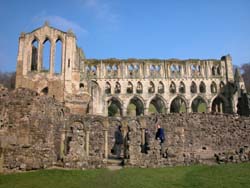 |
 |
 |
 |
 |
 |
 |
|
Introduction All, whether weak or strong, should find
in Rievaulx a haunt The abbey of Rievaulx was founded in 1132. It was built to be the first Cistercian outpost in the North, an abbey from which the White Monks could reform and colonise northern England and Scotland. St Bernard of Clairvaux was the inspiration for the foundation; in March 1132 he sent a colony of monks from Clairvaux, under the direction of his secretary, William, to establish monastic life in Yorkshire. The abbey had tremendous appeal, attracting recruits from near and far, as well as high-profile benefactors such as Henry II (1135-1154) and King David of Scotland (1124-1153). The mid-twelfth century was a highpoint in Rievaulx’s history with an increase in numbers, benefactors and holdings, but the abbey enjoyed success throughout the Middle Ages and remained the most prominent of the Northern English houses. Nevertheless, the community had to face a number of problems including financial difficulties, war, famine and cattle diseases. The Black Death of 1348-9 had a devastating impact on numbers and by the late fourteenth century there were only fourteen monks, three lay-brothers and an abbot. At the Dissolution of the abbey in 1538 the community numbered twenty-three. A striking testimony to Rievaulx’s high reputation is the fact that three of its former members were celebrated as saints: William, the founding abbot, Aelred, the third abbot, and Waldef, at one time monk of Rievaulx and later abbot of its daughter-house, Melrose.
|
